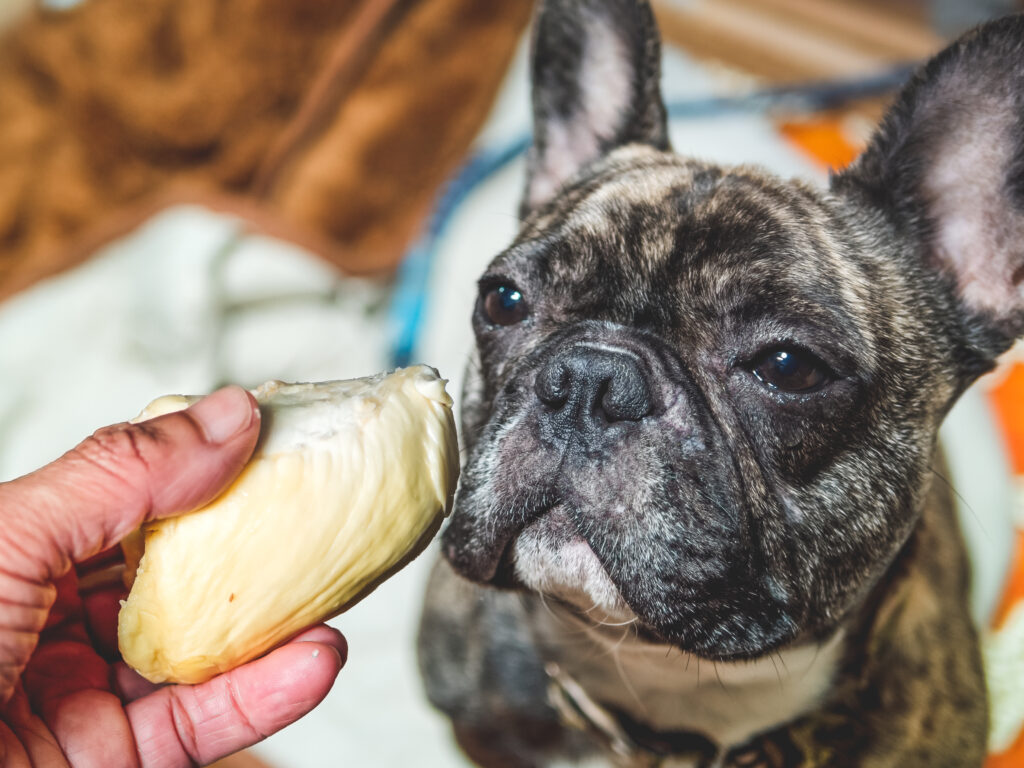Dogs enjoy all sorts of treats, no matter what they look like or what they are made of. That being said, as pet owners, we just can’t help but spoil our dogs with bits and pieces of what we eat once they give you that look (yes, those irresistible sparkly eyes that get you each time). From vegetables to fruits, you may wonder if some of those can be eaten by your dogs. For example, exotic fruits like durian. Can dogs eat durian?
To answer that question: yes, they can. However, pet owners can only feed them the meat of the fruit and avoid the outer layers and seeds at all costs. You can easily prep them and give them to your dogs in small amounts.
But with every new food you want to introduce to your dog’s palette, you want to be careful and check for every reaction that it may cause. Below, we’ll talk more about durians, their benefits, and what to look out for when feeding them to your pet.
What is Durian?
Durian is a large fruit with a prickly outer appearance, and, once opened, contains a silky, smooth yellow flesh inside. It can mostly be found in Southeast Asian countries, where it grows on trees. It’s most notably known for its repugnant odour which many people find revolting. Contrary to its unpleasant odour, the fruit is actually really sweet. Admittedly, eating this fruit isn’t for everyone since the smell can really turn anyone away. But, if you can get past the smell and try it yourself, the fruit is yummy!
Can Dogs Eat Durian
Yes, dogs can eat durian, but they can only eat the yellow flesh of the fruit in small amounts. Make sure to avoid feeding them the outer layer with the spikes and never feed them the seeds, since they are known to be poisonous due to their cyanide content. Dogs that ingest cyanide will end up seriously ill, which may lead to death.
Health Benefits of Durian for Dogs
The durian fruit is rich in vitamins, nutrients, and minerals such as vitamins A and C, B6, calcium, iron, zinc, and magnesium. However, they also contain high amounts of fats and calories, so they are usually recommended to be included in diets if your dog has trouble gaining weight or maintaining a healthy weight. The ideal intake of durian for dogs is by small amounts. So, if you have durian fruit, take out the yellow meat, get rid of the seed, then cut them up into smaller pieces. You can control the amount of durian fruit you can give to your dog, but as the general rule goes, don’t overfeed them with these fruits. You can give durian as an occasional treat to your pooch.
Otherwise, if your dog is prone to gaining weight or obesity, it’s better to stave off these delicacies. Make sure to avoid it if you find your dog to be allergic to them, too. You may further consult with your veterinarian for diet recommendations.
Are There Any Concerns?
First things first, the only part of the durian you should be feeding your dog is the yellow flesh inside the fruit. Never give them any parts of their outer spiky layers and their seed to avoid causing harm to your pooch.
If it’s your dog’s first time trying durian, you can give them a small piece to start with. After ingesting the fruit, observe your dog for any signs of reactions. Since the fruit contains high amounts of natural sugars, feeding your pet too much of it may cause them to get a burst of energy. They may also end up bloating, getting cramps or stomachaches, fatigue, vomiting, and lethargy if they eat too much durian fruit. So, make sure to control the amount of fruit to give them and avoid going overboard with those.
On the other hand, durian may not be compatible with your dog’s stomach. Look out for reactions such as vomiting, laziness, tiredness, diarrhea, loose or bloody stool, or constipation which can indicate that durian may not be ideal to give to your dog. Bring your dog immediately to your vet to get them treated if it becomes worse.
Can Dogs Be Allergic To Durian?
It may taste good for your pet, but their body may not feel the same, and will end up rejecting the durian fruit. To find out if your dog is allergic to the fruit, it will manifest itself in different ways such as getting itchy, hives, indigestion, redness and irritation, and swelling on the ears, paws, and face.
Conclusion
Dogs can safely eat durian as long as they are fed in small amounts occasionally as treat alternatives. They don’t necessarily need to be a part of their daily diet, but they can eat them from time to time. Just as long as you only give them the yellow flesh and avoid the spikes and seeds. If it’s the first time, look out for signs of how your dog’s body reacts after eating the durian fruit. Check their behaviour and physical symptoms and if they react adversely to the fruit, immediately stop feeding them and take them to the vet to have them checked.


